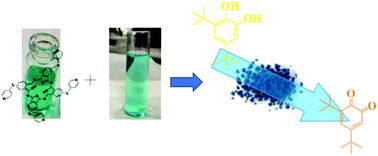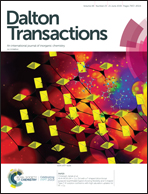Copper-phthalocyanine coordination polymer as a reusable catechol oxidase biomimetic catalyst†
Abstract
The development of selective, efficient, and recoverable/reusable catalysts for oxidation reactions has become one of the main challenges of modern chemistry. Considering our interest in efficient catalytic systems based on porphyrin (Por) and phthalocyanine (Pc) coordination polymers, we report here the synthesis, characterization and catalytic activity of a new Pc coordination polymer (coined hereafter as Cu4CuPcSPy). The new Pc material was obtained in excellent yield, from the reaction of H2PcSPy with an excess amount of copper(II) acetate. The catalytic efficiency of Cu4CuPcSPy was evaluated in the oxidation of 3,5-di-tert-butylcatechol (3,5-DTBC) in the presence of molecular oxygen from air, with or without the addition of aqueous 30% hydrogen peroxide. The comparison between the homogeneous (CuPcSPy) and the heterogeneous (Cu4CuPcSPy) catalytic systems showed a better performance for the Cu4CuPcSPy material, that can be recovered by filtration and reused, maintaining its activity roughly unchanged during three catalytic cycles. An increment of approximately 30% was also verified in the catalytic activity of the homogeneous and heterogeneous systems by adding aqueous hydrogen peroxide to the catalytic reactions.

- This article is part of the themed collection: Nitrogen Ligands


 Please wait while we load your content...
Please wait while we load your content...